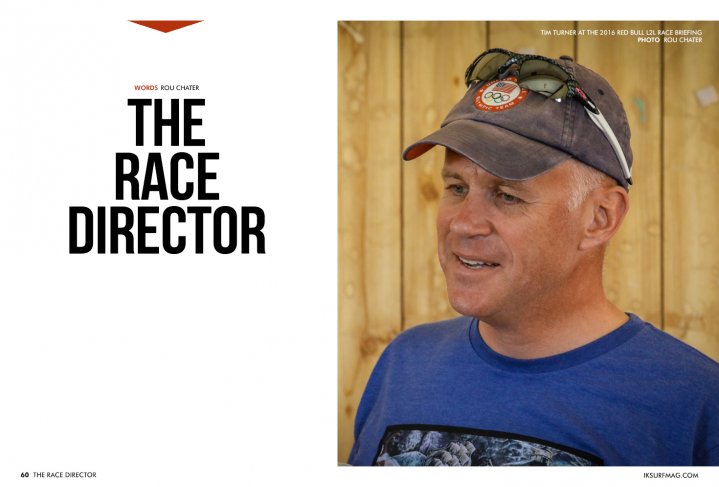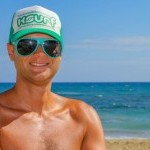
The Race Director
Issue 60 / Tue 6th Dec, 2016
We chat to Tim Turner, the man behind one of the biggest long distance kite races on the planet about what makes the event so popular and so successful, and also about how Nico Parlier can travel at 60kph for 19 minutes straight!
There is an unsung hero behind every kitesurfing event that ever takes place. Someone who painstakingly dedicates days of hard labour to the job in hand and who has no chance of lifting the trophy, although there is a good chance he paid for them! Tim Turner is the legend behind the hugely popular Red Bull Lighthouse 2 Leighton event in Western Australia. This year saw the course record smashed by Nico Parlier on a hydrofoil; he averaged 60km an hour for 19 minutes as he crossed from Rottnest Island to Perth, a record we may not see broken for a while.
In an effort to celebrate the unsung heroes of the sport we talked to Tim about the race, how it came about and some of the decisions and challenges he faces when making it happen. Having attended the race for three years now, we honestly can't recommend it enough, more and more people entering from overseas, perhaps next year is the one to tick this off your kitesurfing bucket list!
When did you first run the race and where did the idea come from?
We created the event after a speed trip to Namibia and a test run to see if the concept would work in March 2010. Over that Winter (for Australia) I started to build the concept and approached Red Bull out of the blue with the idea. As luck would have it, their Western Australian Field Marketing Manager, Ross Wyness, shared the vision and the Lighthouse 2 Leighton first happened in 2010. We had about 75 people do the first one. My friend, Alex Caizergues from France won on a speed board in 23 minutes.
How has the race changed from those early days?
It’s gotten bigger! Across every metric really. The prize list now is close to $10,000 thanks to the great support we receive from the State Government. The field every year, in terms of truly World Class quality, gets much, much deeper. Year one, Alex was one rock star racer. This year, there were 15, at least.
It’s a massive operation, involving transporting lots of riders and equipment over to Rottnest and getting them back safely, how do you manage that, who helps out in terms of logistics?
Regarding the pre-work, I handle the bulk of it. I use amazing event management software called Cvent that makes life easy and very professional. However, on race day the amazing team that supports the event swings into action. It is an amazing demonstration of getting multiple fantastic volunteer teams working so well together. The team at Rottnest Express, the ferry business, transport us, 150 racers and volunteers to Rottnest, and then a great team at the island move the gear to the Event HQ.
On the course, the Fremantle Sailing Club are utterly brilliant with their water safety, this year with fantastic weather I believe there were only three rescues, which is great. WAKSA provide volunteers to help out on the island launching and also landing racers kites at the finish. Then two of my very long-standing boating friends are Chief Starter (Tim Browning) and Head Judge (Rob Bentley). Both have been on board since inception and totally get what we are trying to achieve and have created.
The last two years have seen some tricky weather conditions, this year the race got postponed until the Sunday, how difficult is it to make those decisions? Do you have contingencies in place to make that happen?
It’s tough to make the call to defer as it creates a truckload of extra work and all at very, very short notice. But, we have such good available weather data available to us, it pays not to be an optimist and second-guess it. This year the forecast was for mild and very westerly winds and 100% cloud cover on Saturday. Sunday was forecast to be much better. It just made sense. I never want to have to say to myself: “with the benefit of hindsight.”
The safety of 130 people is on my personal watch. I simply have to get it right. The event is just so good when you can dial your kite into the zone and power across the channel, whether you are Nico Parlier at 33 knots, or a back marker on a TT. Having to figure of eight your kite across in light winds is no fun at all.
Steph Bridge won the race again this year, who’s the most successful competitor in terms of race wins?
Yes, that would be Steph, each year she puts in a phenomenal performance. I love the fact there have been seven individual overall winners – that’s so good. It shows that no one rider has dominated the whole event.
2016 saw a huge contingent of international riders, was that your vision when you started is it something that has grown organically?
I’d always believed it could grow. Every year we have increased numbers. I’m confident that 135 is just the right amount. We limit the entrants due to the size of the launching beach; it's not a big area to get 135 people off in less than 20 minutes. The good winds this year helped, people could launch quickly and get out there. In prior years in less wind, it can be really tricky! We have over 200 people apply every year. So it’s great to have demand outstrip the places available.
What’s the biggest challenge on the day of the race, or does it all run like clockwork once race day arrives?
In all seriousness, the greatest challenge is getting EVERY racer to read the Competitor Manual! Thankfully, we work really hard to ensure that every I is dotted and T crossed so that, per Mihaly Csikszentmihalyi, we get in a state of flow and it all works, like clockwork!
You’ve got some big sponsors on board, how difficult is it to attract that support, or does the legacy of a fantastic event help?
We’ve worked purposely with a small number of very good sponsors. Yes, it’s hard to get new ones on board. There is a tremendous opportunity for a leading kite brand to partner with the race. Cabrinha and the local shop, Kite Addiction, supported the event fabulously from inception and for the first six years, which was great. I’m confident we will have a new kite partner on board for future years. Red Bull are 100% confirmed for 2017 already!
It’s a big shipping channel; do you need to manage that with the port authorities to get the all clear for the race?
The channel itself is actually really narrow, about 500m I think, last time I crossed, and it depends on where you cross. The big ships are only allowed to steam in that channel. That said, we do work very closely with the Port Authority who very generously allow us to kite across and provide an update on commercial shipping movements, which are more than you’d actually imagine! Fremantle is one very busy port.
As well, the WA Department of Transport generously approve the race and allow us exemptions from carrying EPIRBs and parachute flares. Their approval is what allows the race to go ahead and we never want to lose sight of that. I take receiving that approval letter very, very seriously. I should also mention that insuring the event annually is over $5,000 should anyone wonder where a chunk of the entry fee goes! In date flares, race rashies from France that everyone gets to keep, 200 event T-shirts free for racers and volunteers is the print run, $10k of prizes, and $5k of trophies…
We’ve created an indulgent race experience here for everyone. I think that’s why it is so popular and everyone loves the day so much. And, I think that’s why I do it – the positive feedback I receive each year is heartening and makes it all worthwhile.
We know it’s notoriously full of big fish out there, have you ever had any sightings of sharks? I know it’s something Sam Light worries about!
In all honesty, no. Interestingly, my brother is actually the President of the Rottenest Channel Swim Association this year. That’s where over 1,000 people swim from Cottesloe to Rottnest. I think he’s got sharks more on his mind than me! I’ve sailed and kited these waters for 20 years and never seen a big one. We go too fast now!
This year the record got smashed to 19 minutes and 3 seconds, do you think that’s going to stand for a while?
You’d think so, but it sounds like Nico said he could go faster. He had some weed on his foil and shifted course and gybed towards the end we noticed from the media boat. If he was pushed by anyone, then that could make it faster again. I can see we will need a faster and bigger media boat next year. His speed was like nothing I’ve seen. Just so fast!
Aaron Hadlow came and beat some of the racers and foilers on his twin tip, does that open the race up again a bit more to the riders not on high tech equipment do you think?
The top guys will always (now) be on foils. So unless you are in that realm, you’ll have no chance! That’s why the TT class is so good. It does give everyone a chance. Well, it did until Aaron and Sam decided to come racing –which is brilliant I do hasten to say. Personally, I was so stoked to hear Aaron was racing. He’s such a nice guy and to win his main sponsor's race is just superb.
Nico Parlier looked unbeatable; do you think he’ll be back to defend his title in 2017?
I have no doubt he’ll be back. I believe the Hydrofoil Pro Tour will be here in WA again in 2017; so we’ll certainly be working closely with Andy Hansen to make sure the two events align again.
The Marc Sprod memorial trophy goes to the fastest Western Australian over the course, can you tell us a little bit about the trophy and why it’s so important?
Yes, Marc was a well-liked and very competent kiter who tragically died at Dutch Inn beach while kiting in a frontal winter storm. We wanted to pay respect to his life and love of kiting, and I could see that as the race grew it was going to get harder for a local to win. It made sense to have a highest placed Western Australian recognised annually. I’d love for his son, Milo, to attend in a year or two when he is older and present the trophy to the winner. That would be special.
When does the planning start for next year?
Well. I created a couple of weeks ago a folder on my Mac L2L 2017….
Cheers Tim thanks for taking the time!
Videos
By Rou Chater
Rou has been kiting since the sports inception and has been working as an editor and tester for magazines since 2004. He started IKSURFMAG with his brother in 2006 and has tested hundreds of different kites and travelled all over the world to kitesurf. He's a walking encyclopedia of all things kite and is just as passionate about the sport today as he was when he first started!






















